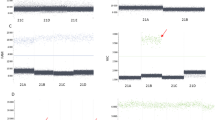Abstract
Purpose
To examine the potential high throughput capability and efficiency of an automated DNA extraction system in combination with mass spectrometry for the non-invasive determination of the foetal Rhesus D status.
Methods
A total of 178 maternal plasma samples from RHD-negative pregnant women were examined, from which DNA was extracted using the automated Roche MagNA Pure™ system. Presence of the foetal RHD gene was detected by PCR for RHD exon 7 and subsequent analysis using the Sequenom MassArray™ mass spectrometric system.
Results
We determined that as little as 15 pg of RHD-positive genomic DNA could be detected in a background of 585 pg of RHD-negative genomic DNA. The analysis of the clinical samples yielded a sensitivity and specificity of 96.1 and 96.1%, respectively.
Conclusion
Our study indicated that automated DNA extraction in combination with mass spectrometry permits the determination of foetal Rhesus D genotype with an accuracy comparable to the current approaches using real-time PCR.

Similar content being viewed by others
References
Avent ND (2008) RHD genotyping from maternal plasma: guidelines and technical challenges. Methods Mol Biol 444:185–201. doi:10.1007/978-1-59745-066-9_14
Bianchi DW, Avent ND, Costa JM, van der Schoot CE (2005) Noninvasive prenatal diagnosis of fetal Rhesus D: ready for prime(r) time. Obstet Gynecol 106:841–844
Chan KC, Ding C, Gerovassili A, Yeung SW, Chiu RW, Leung TN et al (2006) Hypermethylated RASSF1A in maternal plasma: a universal fetal DNA marker that improves the reliability of noninvasive prenatal diagnosis. Clin Chem 52:2211–2218. doi:10.1373/clinchem.2006.074997
Costa JM, Giovangrandi Y, Ernault P, Lohmann L, Nataf V, El HN et al (2002) Fetal RHD genotyping in maternal serum during the first trimester of pregnancy. Br J Haematol 119:255–260. doi:10.1046/j.1365-2141.2002.03780.x
Ding C (2008) Maldi-TOF mass spectrometry for analyzing cell-free fetal DNA in maternal plasma. Methods Mol Biol 444:253–267. doi:10.1007/978-1-59745-066-9_20
Finning K, Martin P, Daniels G (2004) A clinical service in the UK to predict fetal Rh (Rhesus) D blood group using free fetal DNA in maternal plasma. Ann N Y Acad Sci 1022:119–123. doi:10.1196/annals.1318.019
Finning K, Martin P, Summers J, Massey E, Poole G, Daniels G (2008) Effect of high throughput RHD typing of fetal DNA in maternal plasma on use of anti-RhD immunoglobulin in RhD negative pregnant women: prospective feasibility study. BMJ 336:816–818. doi:10.1136/bmj.39518.463206.25
Finning KM, Chitty LS (2008) Non-invasive fetal sex determination: impact on clinical practice. Semin Fetal Neonatal Med 13:69–75. doi:10.1016/j.siny.2007.12.007
Harper TC, Finning KM, Martin P, Moise KJ Jr (2004) Use of maternal plasma for noninvasive determination of fetal RhD status. Am J Obstet Gynecol 191:1730–1732. doi:10.1016/j.ajog.2004.06.098
Legler TJ, Lynen R, Maas JH, Pindur G, Kulenkampff D, Suren A et al (2002) Prediction of fetal Rh D and Rh CcEe phenotype from maternal plasma with real-time polymerase chain reaction. Transfus Apher Sci 27:217–223. doi:10.1016/S1473-0502(02)00068-X
Li Y, Finning K, Daniels G, Hahn S, Zhong X, Holzgreve W (2008) Noninvasive genotyping fetal Kell blood group (KEL1) using cell-free fetal DNA in maternal plasma by MALDI-TOF mass spectrometry. Prenat Diagn 28:203–208. doi:10.1002/pd.1936
Li Y, Wenzel F, Holzgreve W, Hahn S (2006) Genotyping fetal paternally inherited SNPs by MALDI-TOF MS using cell-free fetal DNA in maternal plasma: influence of size fractionation. Electrophoresis 27:3889–3896. doi:10.1002/elps.200600084
Lo YM, Hjelm NM, Fidler C, Sargent IL, Murphy MF, Chamberlain PF et al (1998) Prenatal diagnosis of fetal RhD status by molecular analysis of maternal plasma. N Engl J Med 339:1734–1738. doi:10.1056/NEJM199812103392402
Maron JL, Bianchi DW (2007) Prenatal diagnosis using cell-free nucleic acids in maternal body fluids: a decade of progress. Am J Med Genet C Semin Med Genet 145:5–17. doi:10.1002/ajmg.c.30115
Rouillac-Le SC, Puillandre P, Gillot R, Baulard C, Metral S, Le Van KC et al (2004) Large-scale pre-diagnosis study of fetal RHD genotyping by PCR on plasma DNA from RhD-negative pregnant women. Mol Diagn 8:23–31. doi:10.2165/00066982-200408010-00004
van der Schoot CE, Hahn S, Chitty LS (2008) Non-invasive prenatal diagnosis and determination of fetal Rh status. Semin Fetal Neonatal Med 13:63–68. doi:10.1016/j.siny.2007.12.012
van der Schoot CE, Soussan AA, Koelewijn J, Bonsel G, Paget-Christiaens LG, de HM (2006) Non-invasive antenatal RHD typing. Transfus Clin Biol 13:53–57. doi:10.1016/j.tracli.2006.02.021
Xiu-Cheng FA, Garritsen HS, Tarhouny SE, Morris M, Hahn S, Holzgreve W et al (2008) A rapid and accurate approach to identify single nucleotide polymorphisms of mitochondrial DNA using MALDI-TOF mass spectrometry. Clin Chem Lab Med 46:299–305. doi:10.1515/CCLM.2008.071
Zhong XY, Holzgreve W, Hahn S (2001) Risk free simultaneous prenatal identification of fetal Rhesus D status and sex by multiplex real-time PCR using cell free fetal DNA in maternal plasma. Swiss Med Wkly 131:70–74
Acknowledgments
Funding from the European Commission for the Special Non-invasive Advances in Fetal and Neonatal Evaluation (SAFE) Network of Excellence (LSHB-CT-2004-503243) and the Swiss National Science Foundation (SNSF 3200B0-107697/1), from which this study was partially funded, is gratefully acknowledged.
Author information
Authors and Affiliations
Corresponding author
Rights and permissions
About this article
Cite this article
Grill, S., Banzola, I., Li, Y. et al. High throughput non-invasive determination of foetal Rhesus D status using automated extraction of cell-free foetal DNA in maternal plasma and mass spectrometry. Arch Gynecol Obstet 279, 533–537 (2009). https://doi.org/10.1007/s00404-008-0774-5
Received:
Accepted:
Published:
Issue Date:
DOI: https://doi.org/10.1007/s00404-008-0774-5




